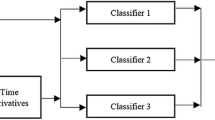Abstract
This paper investigates the feed forward back propagation neural network (FFBPNN) and the support vector machine (SVM) for the classification of two Maghrebian dialects: Tunisian and Moroccan. The dialect used by the Moroccan speakers is called “La Darijja” and that of Tunisians is called “Darija”. An Automatic Speech Recognition System is implemented in order to identify ten Arabic digits (from zero to nine). The implementation of our present system consists of two phases: The features extraction using a variety of popular hybrid techniques and the classification phase using separately the FFBPNN and the SVM. The experimental results showed that the recognition rates with both approaches have reached 98.3 % with FFBPNN and 97.5 % with SVM.


Similar content being viewed by others
References
Alorifis, F. S. (2008). Automatic identification of arabic dialects using hidden markov models, Thesis, University of Pittsburgh.
Ameen, A., Uma, R., & Madhusudana, R. (2012). Speaker recognition system using combined vector quantization and discrete Hidden Markov model. International Journal Of Computational Engineering Research, 2(3), 2250–3005.
Amour, M., Bouhjar, A., & Boukhris, F. (2004). Introduction to amazigh language. Paris: IRCAM.
Antoniol, G., Rollo, V. F., & Venturi, G. (2005). Linear Predictive Coding and Cepstrum coefficients for mining time variant information from software repositories. St. Louis: International Workshop on Mining Software Repositories.
Barkat-Defradas, M., Hamdi, R., & Pellegrino, F. (2004). From linguistic characterization to automatic identification of arabic dialects (pp. 29–30). Paris: MIDL.
Biadsy, F. Hirschberg, J. & Habash, N. (2009). Spoken arabic dialect identification using phonotactic modeling. In Proceedings of the Workshop on Computational Approaches to Semitic Languages at the meeting of the European Association for Computational Linguistics (EACL), Athens.
Boril, H., Sangwan, A., Hansen, J, H.L. (2012). Arabic Dialect Identification—‘Is the Secret in the Silence and Other Observations”, Center for Robust Speech Systems (CRSS), Erik Jonsson School of Engineering,University of Texas at Dallas, Richardson, INTERSPEECH.
Boukous, A. (1998). The Moroccan Sociolinguistic Situation. Plurilinguismes (Le Maroc) (Vol. 16, pp. 5–30). Paris: Centre d’Etudes et de Recherches en Planification Linguistique.
Chang, C.-C. & Lin, C.-J. (2004). LIBSVM—a library for support vector Machines, 2004. http://www.csie.edu.tw/cjlin/libsvm/.
Burges, C. J. C. (1998). A tutorial on support vector machines for pattern recognition. Data Mining and Knowledge Discovery, 2, 121–167.
Cobert, D. (2003). Darija, A language of Modernity, estidios dialectlogia norteafricana y andalusi, 2003.
Dasigi, P., & Diab, M. (2011). CODACT: towards identifying orthographic variants in dialectal arabic, In Proceedings of the 5th International Joint Conference on Natural Language Processing (pp. 318–326), Chiang Mai, Thailand, 8–13.
Diab, M., Hacioglu, K., & Jurafsky, D. (2007). Automated methods for processing Arabic text: From Tokenization to base phrase chunking. In A. den van Bosch, A. den van Bosch, & A. Soudi (Eds.), Arabic computational morphology: Knowledge-based and empirical methods. New York: Springer.
Elfardy, H. & Diab, M. (2103) Sentence-level dialect identification in arabic.In Proceedings of the 51st AnnualMeeting of the Association for Computational Linguistics, ACL 2013, Sofia.
Gunawan, W., & Hasegawa-Johnson, M. (2001). PLP coefficients can be quantized at 400 bps (pp. 1–4). Salt Lake City: ICASSP.
Habash, N., Rambow, O., & Roth, R. (2009). MADA + TOKAN, A toolkit for Arabic tokenization, diacritization, morphological disambiguation, POS tagging, stemming and lemmatization. In K. Choukri, & B. Maegaard (Eds.) Proceedings of the second international conference on Arabic Language resources and tools. The MEDAR Consortium.
Habash, N., Roth, R., Rambow, O., Eskander, R., & Tomeh, N. (2013). Morphological Analysis and Disambiguation for Dialectal Arabic, In Proceedings of the 2013 conference of the North American chapter of the association for computational linguistics: Human language technologies (NAACL-HLT), Atlanta.
Hamdi, R., (2007). Rhythmic variation in arabic dialects, Thèse Université 7 novembre de Carthage Tunisie.
Hassine, M., Boussaid, L., & Messaoud, H. (2015). Hybrid techniques for Arabic Letter recognition. International Journal of Intelligent Information Systems, 4(1), 27–34.
Haykin, S. (2009). Neural networks and learning machines. New York: Prentice Hall.
Hermansky, H. (1990). Perceptual linear predictive (PLP) analysis for speech. The Journal of the Acoustical Society of America, 87, 1738–1752.
Lindasalwa, M., Mumtaj, B., & Elamvazuthi, I. (2010). Voice recognition algorithms using mel frequency cepstral coefficient (MFCC) and dynamic time warping (DTW) techniques. Journal of Computing, 2(3)
MATLAB User’s Guide. Mathworks Inc., 2006.
Nour-Eddine, L., & Abdelkader, A. (2015). GMM-Based Maghreb Dialect Identification System. Journal of Information Processing Systems, 11(1), 22–38.
Pasha, Arfath, Al-Badrashinyy, Mohamed, Diaby, Mona, El Kholy, Ahmed, Eskander, Ramy, Habash, Nizar, et al. (2014). MADAMIRA: A fast, comprehensive tool for morphological analysis and disambiguation of Arabic. New York: Columbia University, Center for Computational Learning Systems, LREC.
Price, J. Sophomore student (2005) Design an automatic speech recognition system using maltab. In Progress report for: Chesapeake information based aeronautics consortium August 2005, University of Maryland Eastern Shore Princess Anne.
Sadat, F., Kazemi, F., & Farzindar, A. (2014). Automatic dentification of Arabic Language Varieties and Dialects in Social Media, In Proceedings of the Second Workshop on Natural Language Processing for Social Media (SocialNLP) (pp. 22–27), Dublin, August 24 2014.
Semet, G., & Treffo, G. (2002). Speech recognition based on MFCC coefficients, TIPE.
Shlens J. (2003). A tutorial on principal component analysis, Derivation, Discussion and Singular Value Decomposition.
Smola, A.J. & Scholkopf, B. (1998) A tutorial on support vector regression, Tech. rep., NeuroCOLT2 Technical Report NC2-TR-1998-030.
Srinivasan, A. (2011). Speech recognition using hidden markov model. Applied Mathematical Sciences, 5(79), 3943–3948.
Venkateswarlu, R.L.K., Kumari, R. V. & Vani Jayasri, G. (2011). Speech recognition using radial basis function neural network, IEEE.
Yu, H. & Kim, S. (2012). SVM tutorial: Classification, regression, and ranking. In Handbook of Natural Computing (pp. 479–506).
Author information
Authors and Affiliations
Corresponding author
Rights and permissions
About this article
Cite this article
Hassine, M., Boussaid, L. & Messaoud, H. Maghrebian dialect recognition based on support vector machines and neural network classifiers. Int J Speech Technol 19, 687–695 (2016). https://doi.org/10.1007/s10772-016-9360-6
Received:
Accepted:
Published:
Issue Date:
DOI: https://doi.org/10.1007/s10772-016-9360-6




